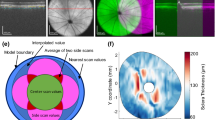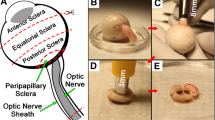Abstract
Biomechanical factors acting within the optic nerve head (ONH) likely play a role in the loss of vision that occurs in glaucoma. In a companion paper (Sigal et al. 2008), we quantified the biomechanical environment within individual-specific ONH models reconstructed from human post mortem eyes. Our goal in this manuscript was to use finite element modeling to investigate the influence of tissue material properties on ONH biomechanics in these same individual-specific models. A sensitivity analysis was carried out by simulating the effects of changing intraocular pressure on ONH biomechanics as tissue mechanical properties were systematically varied over ranges reported in the literature. This procedure was repeated for each individual-specific model described in the companion paper (Sigal et al. 2008). The outcome measures of the analysis were first and third principal strains, as well as the derived quantity of maximum shear strain, in ONH tissues. Scleral stiffness had by far the largest influence in ONH biomechanics, and this result was remarkably consistent across ONH models. The stiffnesses of the lamina cribrosa and pia mater were also influential. These results are consistent with those obtained using generic ONH models. The compressibility of the pre-laminar neural tissue influenced compressive and shearing strains. Overall, tissue material properties had a much greater influence on ONH biomechanics than did tissue geometry, as assessed by comparing results between our individual-specific models. Material properties of ONH tissues, particularly of the peripapillary sclera, play a dominant role in the mechanical response of an ONH to acute changes in IOP and may be important in the pathogenesis of glaucoma. We need to better understand inter-individual differences in scleral biomechanical properties and whether they are clinically important.
Similar content being viewed by others
References
Battaglioli JL and Kamm RD (1984). Measurements of the compressive properties of scleral tissue. Invest Ophthalmol Vis Sci 25(1): 59–65
Cook RD (1995). Finite element modeling for stress analysis. Wiley, New York
Downs JC, Suh JK, Thomas KA, Bellezza AJ, Burgoyne CF and Hart RT (2003). Viscoelastic characterization of peripapillary sclera: material properties by quadrant in rabbit and monkey eyes. J Biomech Eng 125(1): 124–131
Downs JC, Suh JK, Thomas KA, Bellezza AJ, Hart RT and Burgoyne CF (2005). Viscoelastic material properties of the peripapillary sclera in normal and early-glaucoma monkey eyes. Invest Ophthalmol Vis Sci 46(2): 540–546
Edwards ME and Good TA (2001). Use of a mathematical model to estimate stress and strain during elevated pressure induced lamina cribrosa deformation. Curr Eye Res 23(3): 215–225
Eilaghi A, Sigal IA, Olesen CG, et al (2007) The effect of nonlinear scleral properties on optic nerve head biomechanics. Summer bioengineering conference 2007. Keystone, Colorado
Friberg TR and Lace JW (1988). A comparison of the elastic properties of human choroid and sclera. Exp Eye Res 47(3): 429–436
Henderson FC, Geddes JF, Vaccaro AR, Woodard E, Berry KJ, Benzel EC (2005) Stretch-associated injury in cervical spondylotic myelopathy: new concept and review. Neurosurgery 56, 5, 1101–1113; discussion 1101–1113.
Humphrey JD (2006). Cardiovascular solid mechanics. Springer, Heidelberg
Kotliar K, Maier M, Bauer S, Feucht N, Lohmann C and Lanzl I (2007). Effect of intravitreal injections and volume changes on intraocular pressure: clinical results and biomechanical model. Acta Ophthalmol Scand 85(7): 777–781
Olesen CG, Tertinegg I, Eilaghi A, et al (2007) Measuring the biaxial stress-strain characteristics of human sclera. Summer bioengineering conference 2007. Keystone, Colorado
Ozawa H, Matsumoto T, Ohashi T, Sato M and Kokubun S (2004). Mechanical properties and function of the spinal pia mater. J Neurosurg Spine 1(1): 122–127
Sigal IA, Flanagan JG, Tertinegg I and Ethier CR (2004). Finite element modeling of optic nerve head biomechanics. Invest Ophthalmol Vis Sci 45(12): 4378–4387
Sigal IA, Flanagan JG and Ethier CR (2005a). Factors influencing optic nerve head biomechanics. Invest Ophthalmol Vis Sci 46(11): 4189–4199
Sigal IA, Flanagan JG, Tertinegg I and Ethier CR (2005b). Reconstruction of human optic nerve heads for finite element modeling. Technol Health Care 13(4): 313–329
Sigal IA (2006) Human optic nerve head biomechanics: an analysis of generic and individual-specific models using the finite element method. Department of Mechanical and Industrial Engineering, University of Toronto, Toronto
Sigal IA, Flanagan JG, Ethier CR (2007a) Interactions between factors influencing optic nerve head biomechanics. Summer Bioengineering Conference 2007. Keystone, Colorado
Sigal IA, Flanagan JG, Tertinegg I and Ethier CR (2007b). Predicted extension, compression and shearing of optic nerve head tissues. Exp Eye Res 85(3): 312–322
Sigal IA, Flanagan JG, Tertinegg I and Ethier CR (2008). Modeling individual-specific human optic nerve head biomechanics. Part I: IOP-induced deformations and influence of geometry. Biomechan Model Mechanobiol (doi: 10.1007/s10237-008-0120-7)
Spoerl E, Boehm AG and Pillunat LE (2005). The influence of various substances on the biomechanical behavior of lamina cribrosa and peripapillary sclera. Invest Ophthalmol Vis Sci 46(4): 1286–1290
Tunturi AR (1978). Elasticity of the spinal cord, pia and denticulate ligament in the dog. J Neurosurg 48(6): 975–979
Uchio E, Ohno S, Kudoh J, Aoki K and Kisielewicz LT (1999). Simulation model of an eyeball based on finite element analysis on a supercomputer. Br J Ophthalmol 83(10): 1106–1111
Woo SL, Kobayashi AS, Schlegel WA and Lawrence C (1972). Nonlinear material properties of intact cornea and sclera. Exp Eye Res 14(1): 29–39
Author information
Authors and Affiliations
Corresponding author
Additional information
Ian A. Sigal now a post-doctoral research fellow at Ocular Biomechanics Laboratory, Devers Eye Institute, Legacy Health Research. Portland, OR, USA. (isigal@deverseye.org).
Rights and permissions
About this article
Cite this article
Sigal, I.A., Flanagan, J.G., Tertinegg, I. et al. Modeling individual-specific human optic nerve head biomechanics. Part II: influence of material properties. Biomech Model Mechanobiol 8, 99–109 (2009). https://doi.org/10.1007/s10237-008-0119-0
Received:
Accepted:
Published:
Issue Date:
DOI: https://doi.org/10.1007/s10237-008-0119-0




